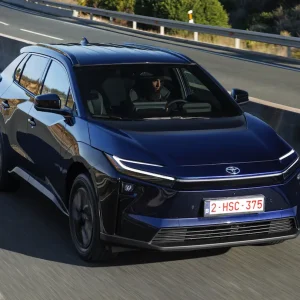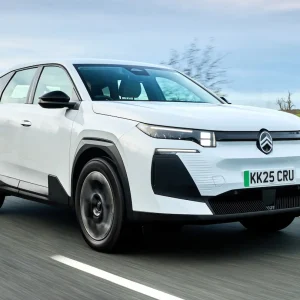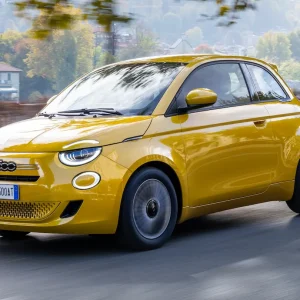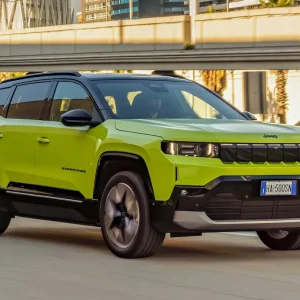4th Report: Truly dynamic performance
Getting out of town is a good thing sometimes. I’m a self-confessed fan of the city and all it can offer, but open roads with few restrictions for cars are becoming things of the past in the Capital. To properly drive anything – let alone a premium EV with real performance dialled into its DNA – you need to go further afield. So a recent 100-mile each-way commute to a car launch in the countryside provided the perfect antidote – and opportunity – for our long-term Jaguar I-Pace to show its hidden skills.
Throughout central London and out the other side up the A40 and M40 the I-Pace is already happy – although its suspension can be a little firm over some city speed bumps – but once decent A roads with gentle curves and good driver sight lines are found, it really comes into its own. As an automatic without paddle-shift anything – even re-generative braking adjustment – there are no extra gears or tweaks to concern yourself with while driving, other than evaluating the twists and turns of the road ahead and steering through them. Even manual foot braking is required less often. Once you learn how hard the I-Pace re-gen brakes itself, you can adjust your driving style, even at speed, with well-placed confidence.
Body control is already decent in regular Comfort or Eco modes – the I-Pace never feels wobbly – but when Dynamic mode is chosen, via a small button on the centre console, things tighten up a notch further while the left-hand side of the car’s driver display temporarily turns red to confirm your choice and the ambient lighting in the door cards, footwells and elsewhere stay red-tinted to keep the mood. But all of those marketing extras pale into insignificance compared to the enhanced real-world driving experience.
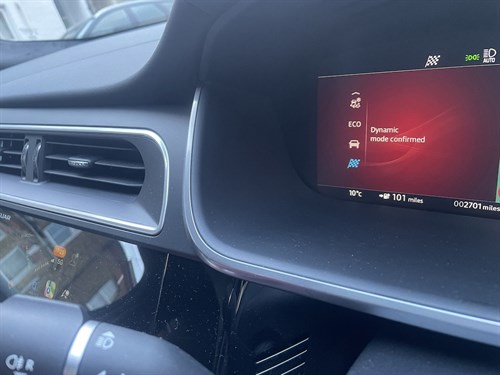
Our car also benefits from the optional £3300 Dynamic Pack, which includes 22in gloss-black wheels, a tailgate spoiler, electronic air suspension, active suspension with adaptive dynamics and surface response. So beyond the solid-feeling but quick-reacting steering and great body control in conditions where lesser EVs appear far less agile, this I-Pace also can automatically lower itself by 10mm when travelling above 65mph for extended periods of time to improve aerodynamic performance. Meanwhile, continuously variable damping technology monitors wheel positions, steering inputs, acceleration and braking to optimally adjust suspension damping settings. A further press of the driving mode button can also implement Jaguar Drive Control with Adaptive Surface Response (or AdSR for short, as it displays in the driver’s instrument cluster). This tech draws on all-wheel drive system expertise to constantly monitor the car’s motor and brake settings to help tackle adverse weather and challenging surfaces. As Jaguar’s press blurb puts it: “This provides the optimum balance between comfort, refinement and agility.” And it’s not wrong. Few cars feel so ‘well-sorted’ dynamically while providing great comfort and stability – no harsh suspension crashes or bangs here.
Furthermore, unlike some more recent EV introductions from rival premium brands, the I-Pace doesn’t endlessly bleep and buzz at the driver for being one mile over the speed limit, or for crossing dotted centre line markings if that’s safer to do than drive through a mystery pothole near to the kerb or hedgerow. Instead it assists and improves your driving, while reassuring and cosseting. Yes, once you move into Dynamic mode, you might notice the car’s driver display taking a couple of miles off your predicted range, should you choose to keep it in that setting for your whole journey, but it’s surely a small price to pay for letting this wonderful ‘cat’ extend its legs once in awhile where conditions allow. Through this lens, the I-Pace really is electric.
3rd Report: Good infotainment, variable sensors
There are lots of things that can potentially go wrong with modern tech-laden cars, especially on the electrical side. But our I-Pace has been pretty even so far. The digital driver display and two central infotainment screens have worked via their associated physical switches and virtual buttons with a level of intuitiveness not always apparent with systems from other car makers, while the bigger two of the three screens mirror-links to my Apple iPhone – wirelessly or via cable – without fuss.
Most cars have two screens to interact with these days, but the I-Pace also has a smaller third one, below the main central screen, for air-conditioning, heated seating and temperature. Framed by two large and smartly-designed push/pull rotary dials for individual driver and passenger air and heat adjustment, it’s perhaps not instantly clear on the move, when to touch the smartly flush screen and when to twist the dials. But after a few exploratory pushes and pulls you quickly get used to it. The screen graphics are also sharp and once the ‘seat heat’ option is made, two graphic renderings of each front seat can be pressed to specifically activate heating on the seat base, seatback – or both – which then turn red to confirm what areas of each are going to warm up soon. In the recent colder weather they’ve been a neat option. Regularly touted as a more energy-efficient way to get one or two humans toasty inside a cold car made for five, compared to turning up the aircon for the whole cabin, it should still be noted that when both heated front seats are deployed, this tech also dents EV range, like A/C. The drop was a not insignificant eight miles last time I checked.
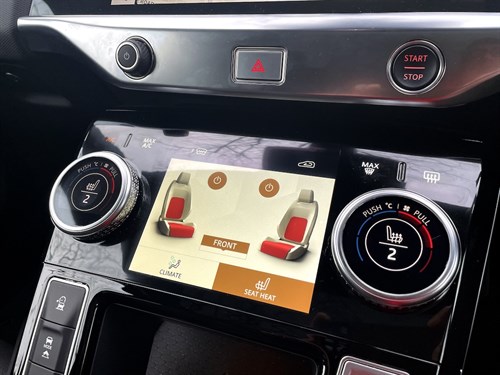
Other reassuring intuitive visual indicators on the I-Pace include the way the car opens and closes. One ‘plip’ of the remote keyfob and the driver’s flush door handle moves away from the bodywork to show that it is open, while two ‘plips’ opens the other three doors and reveals their handles too. At night, there’s also a puddle light on the floor by the front doors when open, which although now a relatively commonplace feature on many new cars, still has the ability to surprise and delight those who’ve not seen it before.
The graphic driver display is also clean and understandable and matched by an app that doesn’t try to do too much, but links with the car and phone easily (Volvo and Citroën take note) while remotely delivering useful info on state of charge, range and recent trips competently. Given that the I-Pace was first introduced in 2018 – and that infotainment can age a car very quickly – it’s to the credit of Jaguar’s engineers and designers that these functions still look and act sharp in 2024.
One small, but annoying exception to the I-Pace’s generally high-performing technology, relates to the car’s tailgate. While most of the I-Pace’s exterior sensors are only too happy to ‘get in a tizz’ at seemingly inanimate large objects they worry are too close and might damage the front or rear of the car when parking, these generally hyper-sensitive sensors either don’t exist or have taken a nap when it comes to the tailgate. On one post-Christmas family mission, after squeezing the 2139mm-wide (with mirrors) car into a tight space within an old hotel car park designed for much smaller ones, we got out and ‘plipped’ the tailgate open – only to see it gently rise upward until it hit the car park ceiling’s low-slung pipework above. Far from a one-off, every time we opened it in that space afterwards we had to place our hand between the pipes and the tailgate to avoid further unwanted clunks. Sub-optimal.
2nd Report: A Tardis, but a ‘thirsty’ one
As a driver, you can be spoilt for space, by car designers and product planners who think they know who usually makes the purchase decision. But however comfortable the driver’s location appears – and in the Jaguar I-Pace it is very comfortable and with great adjustment options for both seat and steering wheel – the acid test of a pleasant journey in any test car is how well my four regular fellow footballers fit in (especially in the second row).
In the case of my previous Citroën C4 X, there was much disgruntlement voiced from the 6ft 3″ duo – Lawyer Steve and Big Dutch Ben – who used to occupy the outside rear seats so that the smaller, but not that small, Dom could sit in the middle. Regularly complaining that the angle of the French Coupé-SUV-saloon’s ceiling and side windows cut into their headroom, when their journey was impaired, so was mine, due to them wingeing about that aspect of rear passenger space.
The new Jaguar I-Pace long-termer isn’t that much longer than the C4 X – 4680 vs 4600mm – but due to its bespoke EV-only platform, the Jag’s wheelbase can be more stretched (2990 vs 2670mm), its width made greater (1895 vs 1834mm) and its roof higher (1566 vs 1525mm) – although its other proportions hide that extra height well. Consequently, these combined dimensional bonuses make a real difference to cabin space. This is especially so at the back where my tall footballing passengers are markedly happier and quieter (about that
topic anyway).
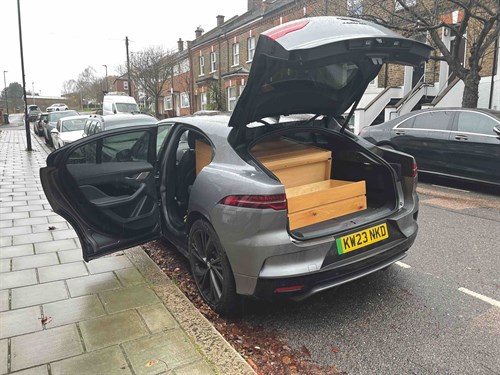
The boot of the I-Pace is decent too. It is not as big as the ‘wet’ 656/1453 min/max litres quoted in my previous report in haste and a pretty pointless measure listed in the official Jaguar press pack, unless you fancy turning your car boot into a temporary fish tank. Don’t. But the much more real-world ‘dry’, solid block, VDA-compliant figures, at 505/1163 litres min/max, are still competitive. For comparison, the nearest-sized, all-wheel drive electric crossover – the Kia EV6 AWD with Premium sound system, offers 480 litres minimum with rear seats up. The I-Pace offers great accessibility to its boot space as well. Most recently, with the rear seats folded almost flat, it swallowed a good-sized chest of drawers whole, sliding between the rear pillars without issue.
Less impressive, are this I-Pace model’s early consumption figures. We’ve charged up five times and the average miles per kilowatt-hour achieved is a lowly 1.8 so far. The car was delivered in late autumn and it’s now firmly winter as I write this report, but it hasn’t been that cold in the south of late – wet and windy yes – but only 8-10 degrees in the daytime. And our journeys have been more city than motorway, which should favour EVs. But this one isn’t topping up to much more than 230 miles when 100% charged either. The I-Pace’s weight, with all those premium goodies added, makes it much heavier than the outgoing mainstream (and smaller) Citroen C4 X long-termer, but I was shocked by the amounts. The C4 X’s six-month (summer) average was 4.0 mi/kWh helped by an official 1621kg kerb weight versus the I-Pace’s 2226kg. Indeed, our real-world I-Pace’s 1.8 mi/kWh is backed up by lowly results in other real-world test results too. According to credible data published by Inside EVs, the I-Pace only beats considerably bigger and heavier premium cars, including the Audi E-Tron and Volvo EX90, plus a host of large electric vans with windows replete with bluff front ends unhelpful for aero, like the VW ID.Buzz and a host of Stellantis nameplates. So we’ll definitely be aiming to improve on that figure in the coming months.
1st Report: Has the I-Pace still got it?
“Are we going to the moon?” my father-in-law said with a smile, when first setting eyes upon our new Jaguar I-Pace long-termer in readiness for his lift home. The 77-year-old might have early-onset Alzheimer’s and Parkinson’s, but fair play, he knows a spaceship when he sees one. And by dint of having a test-driving son-in-law of some 23 years’ standing, he’s got a long and healthy frame of reference.
He’s right of course. The I-Pace does still stand out from the crowd, despite being five years old and with only the mildest of facelifts since, the body-coloured, blanked-out grille being the most obvious visual indicator, compared to the initial open-grilled version. Its excellent proportions – tailored specifically for an EV rather than compromised to fit multiple powertrains both electric and combustion – still translate to short front and especially rear overhangs, with a large cabin and wheelbase in-between. Team those elements with a pronounced and tall sill ‘rocker panel’ that visually cinches in the side, plus a high beltline, and a low and rearward sloping roof and built-in spoiler and the whole ensemble creates a dynamic silhouette. It looks almost as striking now, as when I first laid eyes on the I-Pace concept in person at the 2016 LA Auto Show.
Like all the best production cars, the 2018 showroom-ready model that followed kept that conceptual essence intact and the I-Pace went on to win 62 global awards for both its design and trailblazing technology, including my personal vote for 2019 UK Car of the Year. So I’m a fan. But running one now is a different story. Fleet relevance-wise, the I-Pace will be a crucial car for Jaguar in 2024. Why? Because it has to grapple with the UK Government’s new Zero Emissions Vehicle (ZEV) Mandate legislation, which stipulates that 22% of the sales of every (major) brand selling in the UK will have to be zero-emission – a term now defined as able to drive 100 miles on electric power only. If any vehicle maker fails, it faces massive fines of £15,000 for every car that doesn’t qualify (with a few caveats). And the I-Pace is the only full-electric car Jaguar has until it’s reborn in 2025 as an electric-only marque.
In the ‘plus’ camp, aside from the I-Pace’s still smart exterior looks, is a huge, well-designed and well-appointed interior with three decent screens. One large (12.3in) monitor behind the steering wheel displays directly relevant driving information (but can also display full-width maps too), and there are another two central touchscreens, a larger 10in one for the satnav and infotainment and a smaller 5in one below for aircon and seat heat.
The 400hp from twin electric motors provides all-wheel drive and a 4.5-second 0-60mph time and the 90kWh battery in the R-Dynamic HSE Black EV400 as tested, translates to 255 miles of official WLTP electric-only range. (Other less-powerful or extras-laden I-Pace models boast up to 292 miles). Front room space feels great, rear leg and headroom superb and loadspace under the rear hatch is a useful 656 litres, extending to a maximum 1,453 litres with rear seats folded.
Early journeys have included a long motorway and A-road blast down to the coast which showed off the I-Pace’s effortless performance and sure-footedness, while multiple shorter city missions have revealed its agility and ability to park in pretty tight spots. It’s only 4682mm long and that sawn-off front nose makes it easier to manoeuvre than you’d expect, although you have to get used to ‘knowing’ that fact, rather than physically seeing its extremities from the driver’s seat.
The R-Dynamic HSE Black EV400 is an expensive car though. It has a P11D price of £77,440, on top of which Jaguar has added many extras to push it safely over £80,000, including most significantly the Dynamic Pack which boasts 22in gloss black wheels, a tailgate spoiler and active suspension with adaptive dynamics. But it still feels like one helluva product. Let’s see if we feel the same way after six months.
Standard equipment on R-Dynamic HSE:
Six airbags, all-wheel drive, stability control, low traction and hill launch assist, enhanced brake regen, electric park brake, all surface progress control, emergency brake, rear collision and driver condition monitors, lane keep, blind spot assist, rear camera, front and rear parking sensors, keyless entry, traffic sign recognition, 12-month secure tracker subscription, adaptive cruise control with steering assist, two-zone climate control, power tailgate, digital colour driver display and twin central touchscreens with sat nav, DAB radio, Bluetooth, Apple and Android mirror screening, five USB ports, head-up display, leather sports seats and a home and public charging cable.
Optional equipment (£6280):
Eiger grey paint (£735); Self-seal tyres (£100); Black contrast roof (£520); Dynamic Pack – inc. 22in gloss black wheels, tailgate spoiler, electronic air suspension, active suspension with adaptive dynamics and surface response (£3300); Four-zone climate control (£630); Lockable cooled glovebox (£100); Wi-Fi with one-year subscription data plan (£440); 36-month secure tracker subscription (£340); Powered gesture tailgate (£115);

